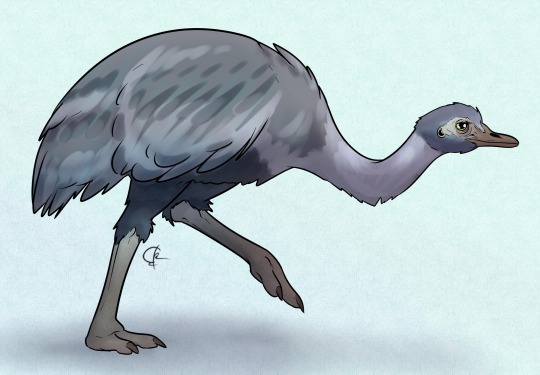#Heterorhea dabbenei
Explore tagged Tumblr posts
Text
Heterorhea dabbenei

By José Carlos Cortés
Etymology: Different Rhea
First Described By: Rovereto, 1914
Classification: Dinosauromorpha, Dinosauriformes, Dracohors, Dinosauria, Saurischia, Eusaurischia, Theropoda, Neotheropoda, Averostra, Tetanurae, Orionides, Avetheropoda, Coelurosauria, Tyrannoraptora, Maniraptoromorpha, Maniraptoriformes, Maniraptora, Pennaraptora, Paraves, Eumaniraptora, Averaptora, Avialae, Euavialae, Avebrevicauda, Pygostaylia, Ornithothoraces, Euornithes, Ornithuromorpha, Ornithurae, Neornithes, Palaeognathae, Notopalaeognathae, Rheiformes, Rheidae
Status: Extinct
Time and Place: About 4 million years ago, in the Zanclean of the Pliocene


Heterorhea is known from the Monte Hermoso Formation of Buenos Aires, Argentina

Physical Description: Heterorhea is only known from some isolated foot bones which were very similar to those of the modern Rhea, but in general shorter and wider. This indicates that, if Heterorhea was indeed a Rhea (see below), it would have been similar to the living Rhea but a little thicker in general proportion. This is, of course, conjecture; but it’s the best one we’ve got, as the original fossil of this animal is lost. Like living Rheas, it probably would have been a shaggy, flightless dinosaur; with a long neck, thick legs, and small pointed beak.
Diet: Heterorhea was probably a vegetation, feeding on broad-leafed plants, fruits, seeds, and roots.
Behavior: Heterorhea probably behaved at least somewhat similar to living Rheas, fairly silent birds forming large flocks fleeing in zig-zag motions. They would probably make calls during the mating season, making somewhat loud calls in mating displays and then making soft sounds to chicks when laid. They were also probably polygamous. Other than that, though, we can’t really make a lot of statements about Heterorhea behavior.
Ecosystem: Heterorhea lived in a wet, lush grassland environment, which would occasionally flood with extensive amounts of water and mud based on the turn of the seasons. This was before the onset of the Ice Age, so it was during a time of somewhat warmer climate than what the later Rheas would face. Here, Heterorhea lived alongside many other animals - a variety of frogs, Ungulates, rodents and rabbits, Toxodonts, Macraucheniids, armadillo relatives, anteaters, Glyptodonts, Thylacosmilus, Racoons, opossums, and so many other mammals. As for contemporary dinosaurs, there were a variety of ducks, the other rhea Hinasuri, Tinamus like Nothura and Eudromia, and - of course - birds of prey like seriemas, condors, and the terror bird Mesembriornis. The latter would, of course, have been a major source of danger for Heterorhea.
Other: Heterorhea is, sadly, lost; this means we can’t actually compare the fossil of this dinosaur with other birds known from the region. Thus, though it was originally called a rhea, we can’t be certain that is what it is - since that assignment came before the age of phylogenetics and more objective classification.
~ By Meig Dickson
Sources Under the Cut
Brodkorb, P. (1963) Catalogue of fossil birds Part 1 (Archaeopterygiformes through Ardeiformes). Bull. Florida State Mus., Biol. Sci., 7: 179-293.
Carroll, R. L. 1988. Vertebrate Paleontology and Evolution 1-698
Deschamps, C. M., G. I. Esteban, and M. S. Bargo. 2001. El registro más antiguo del género Lestodon Gervais, 1855 (Xenarthra, Tardigrada, Mylodontidae) (Montehermosense, Plioceno Temprano). Ameghiniana 38(2):151-156
Deschamps, C. M., M. G. Vucetich, D. H. Verzi and A. I. Olivares. 2012. Biostratigraphy and correlation of the Monte Hermoso Formation (early Pliocene, Argentina): The evidence from caviomorph rodents. Journal of South American Earth Sciences 35:1-9
Deschamps, C. M., and R. L. Tomassini. 2016. Late Cenozoic vertebrates from the Southern Pampean region: systematic and bio-chronostratigraphic update. In M. Martínez, D. Olivera (eds.), Palinología del Meso-Cenozoico de Argentina - Volumen en homenaje a Mirta Elena Quattrocchio 16(2):202-225
Houde, P. W. 1988. Paleognathous birds from the Early Tertiary of the Northern Hemisphere. Publications of the Nuttall Ornithological Club 22:1-148
Lambrecht, K. 1933. Handbuch der Palaeornithologie. 1-1024
Rasia, L. L., and A. M. Candela. 2013. Systematic and biostratigraphic significance of a chinchillid rodent from the Pliocene of eastern Argentina. Acta Palaeontologica Polonica 58(2):241-254
Rovereto, C. 1914. Los Estratos Araucanos y sus fósiles. Anales del Museo de Historia Natural de Buenos Aire 25:1-24
Tambussi, Claudia P., and Federico Degrange. 2012. South American and Antarctic Continental Cenozoic Birds: Paleobiogeographic Affinities and Disparities, 1–113. Springer Science & Business Media. Accessed 2017-10-01.
#Heterorhea#Heterorhea dabbenei#Rhea#Dinosaur#Ratite#Palaeognath#Bird#Birds#Dinosaurs#Neogene#South America#Herbivore#Terrestrial Tuesday#Birblr#Palaeoblr#Factfile#paleontology#prehistory#prehistoric life#biology#a dinosaur a day#a-dinosaur-a-day#dinosaur of the day#dinosaur-of-the-day#science#nature
107 notes
·
View notes